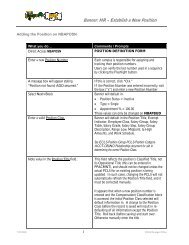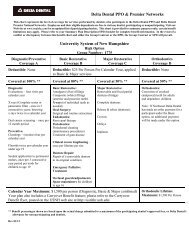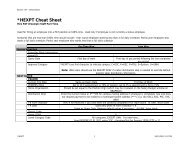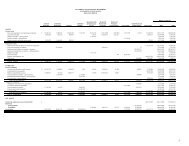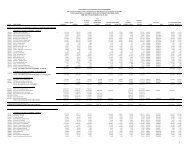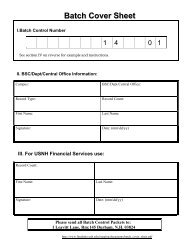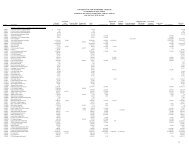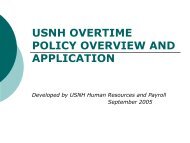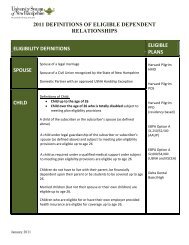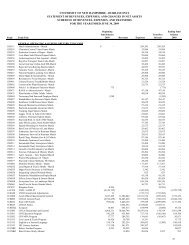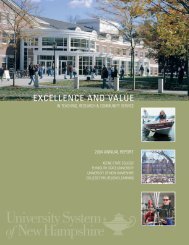2011 Annual Report - USNH Financial Services - University System ...
2011 Annual Report - USNH Financial Services - University System ...
2011 Annual Report - USNH Financial Services - University System ...
Create successful ePaper yourself
Turn your PDF publications into a flip-book with our unique Google optimized e-Paper software.
<strong>USNH</strong> <strong>2011</strong> ANNUAL REPORTNotes to the <strong>Financial</strong> StatementsJune 30, <strong>2011</strong>1. Summary of significant accounting policies andpresentationThe <strong>University</strong> <strong>System</strong> of New Hampshire (<strong>USNH</strong>) is a not-for-profit institution of highereducation created in 1963 as a body politic and corporate under the laws of the State ofNew Hampshire (the state) and tax exempt under Section 501(c)(3) of the Internal RevenueCode. The accompanying financial statements include the accounts of the <strong>University</strong> of NewHampshire at Durham, the <strong>University</strong> of New Hampshire at Manchester, Keene State College,Plymouth State <strong>University</strong>, Granite State College, and all wholly-owned and operated auxiliaryactivities. These organizations are collectively referred to in the accompanying financialstatements as “campuses.”Affiliated entitiesGovernmental Accounting Standards Board (GASB) Statement No. 14, The <strong>Financial</strong> <strong>Report</strong>ingEntity, as amended by GASB Statement No. 39, Determining Whether Certain Organizations AreComponent Units, and GASB Statement No. 61, The <strong>Financial</strong> <strong>Report</strong>ing Entity: Omnibus requiresthat all component units be evaluated for inclusion in the financial statements of the primarygovernment of the reporting entity. Based on management’s evaluation of the individualfinancial burden or benefit relationships, these financial statements also include the accountsof New Hampshire Public Broadcasting (NHPB), the <strong>University</strong> of New Hampshire Foundation,Inc. (UNHF) and the Keene Endowment Association (KEA). NHPB, UNHF and KEA are collectivelyreferred to in the accompanying financial statements as “affiliated entities.” In accordance withthe requirements of the authoritative pronouncements noted above, the associated revenues,expenses, assets, liabilities and net assets have been blended with those of the campuses, andall associated intercompany activity has been eliminated. The affiliated entities are furtherdescribed below.The state’s only public television station, New Hampshire Public Broadcasting, was formerly acomponent unit of the <strong>University</strong> of New Hampshire at Durham and known as New HampshirePublic Television. NHPB underwent a reorganization in 2009 and became a separate, whollyowned501(c)(3) affiliated corporation of <strong>USNH</strong>. NHPB is governed by its own Board ofDirectors, the membership of which includes the Chancellor of <strong>USNH</strong> and four <strong>USNH</strong> Trustees.The <strong>University</strong> of New Hampshire Foundation, Inc. was incorporated in 1989 as a not-for-profit,tax-exempt organization. Its purpose is to solicit, collect, invest and disburse funds for the solebenefit of the <strong>University</strong> of New Hampshire. UNHF is governed by its own Board of Directors,the membership of which includes the President of the <strong>University</strong> of New Hampshire andthree other members of the <strong>USNH</strong> Board of Trustees. The <strong>University</strong> of New Hampshire funds aportion of the operating expenses of UNHF.The Keene Endowment Association was organized in 1957 as a separate charitable entity toprovide financial assistance to deserving students at Keene State College. Income is distributedat the discretion of the Trustees of KEA.Basis of accountingThe accompanying financial statements have been prepared in accordance with accountingprinciples generally accepted in the United States of America as prescribed by the GASB usingthe “economic resources measurement focus” and the accrual basis of accounting.<strong>USNH</strong> follows the requirements of the “business-type activities” (BTA) model as defined byGASB Statement No. 35 Basic <strong>Financial</strong> Statements – and Management’s Discussion and Analysisfor Public Colleges and Universities. BTAs are defined as those that are financed in whole orin part by fees charged to external parties for goods or services. GASB requires that generalpurpose external financial statements be reported on a consolidated basis and that resourcesbe classified into the following net asset categories, as more fully detailed in Note 11:• Invested in capital assets, net of related debt: Property and equipment athistorical cost or fair value on date of gift, net of accumulated depreciationand outstanding principal balances of debt attributable to the acquisition orconstruction of those assets.• Restricted Nonexpendable: Net assets subject to externally imposed stipulationsthat they be maintained permanently by <strong>USNH</strong>. Such net assets include thehistorical gift value of restricted true endowment funds.• Restricted Expendable: Net assets whose use by <strong>USNH</strong> is subject to externallyimposed stipulations. Such net assets include the accumulated net gains ontrue endowment funds as well as the fair value of restricted funds functioning asendowment, restricted funds loaned to students, restricted gifts and endowmentincome, and other similarly restricted funds.• Unrestricted: Net assets that are not subject to externally imposed stipulations.Substantially all unrestricted net assets are designated to support academic, research,or auxiliary enterprises; invested to function as endowment; or committed to capitalconstruction projects.The preparation of financial statements in conformity with accounting principles generallyaccepted in the United States of America requires management to make estimates andassumptions that affect the reported amounts of assets and liabilities, the disclosure ofcontingent assets and liabilities at the date of the financial statements, and the reportedamounts of revenues and expenses during the reporting period. Actual results could differfrom these estimates. The most significant areas that require management estimates relateto valuation of certain investments, useful life and related depreciation of capital assets, andaccruals for postretirement medical and other employee-related benefits.Operating revenues include tuition and fees, grants and contracts, sales of auxiliary services,and other operating revenues. Tuition and fee revenues are reported net of student financialaid discounts and allowances. Operating expenses include employee compensation andbenefits, supplies and services, utilities, and depreciation. Operating expenses also include earlyretirement and other separation incentive stipends and benefits promised to certain employeesin exchange for termination of employment. All such termination benefits are accrued as ofthe date the termination agreement is signed, and are presented at net present value at yearend. Nonoperating revenues (expenses) include all other revenues and expenses except certainchanges in long-term plant, endowment and other net assets, which are reported as otherchanges in net assets. Operating revenues are recognized when earned and expenses arerecorded when incurred. Restricted grant revenue is recognized only to the extent of applicableexpenses incurred or, in the case of fixed-price contracts, when the contract terms are met orcompleted.Investments are maintained with established financial institutions whose credit is evaluated bymanagement and the respective governing boards of <strong>USNH</strong> and its affiliated entities. Highlyliquid investments with a maturity of 90 days or less when purchased are recorded as cashand cash equivalents. Current operating investments have a maturity of more than 90 dayswhen purchased, are highly liquid and are invested for purposes of satisfying current liabilitiesand generating investment income to support operating expenses. Long-term operatinginvestments are unrestricted amounts invested alongside the endowment pool that are notexpected to be liquidated in the next year, but are available for operating purposes if needed.Purchases and sales of investment securities are recorded as of the trade date. Net realized andunrealized gains and losses on endowment investments, as well as interest and dividend yield,are reported as endowment return. Endowment return used for operations per applicationof the endowment spending policy is reported as nonoperating revenue whereas the excess(deficiency) of endowment return over that used for operations is reported as other changes innet assets.In addition to the amounts reported as accounts receivable, <strong>USNH</strong> had unearned grants andcontracts for services not yet performed of $119,323,000 and $128,207,000 at June 30, <strong>2011</strong>and 2010, respectively. This revenue will be reported in subsequent financial statements whenearned. Government grants and contracts also generally provide for reimbursement of facilitiesand administrative costs. Recovery of facilities and administrative costs for the years ended June30, <strong>2011</strong> and 2010 was $20,455,000 and $18,421,000, respectively, and is a component of grantsand contracts revenue.Unconditional pledges of nonendowment gifts are presented net of estimated amountsdeemed uncollectible after discounting to the present value of expected future cash flows.Because of uncertainties with regard to their realization and valuation, bequest intentions andother conditional promises are not recognized as assets until the specified conditions are met. Inaccordance with GASB requirements, endowment pledges totaling $1,839,000 and $2,397,000 atJune 30, <strong>2011</strong> and 2010, respectively, which are expected to be received over the next six years,have not been reported in the accompanying financial statements. <strong>USNH</strong> determines on a caseby-casebasis whether to first apply restricted resources when an expense is incurred where bothrestricted and unrestricted net assets are available.Property and equipment are recorded at original cost for purchased assets or at fair value on thedate of donation in the case of a gift. Equipment with a unit cost of $5,000 or more is capitalized.Building improvements with a cost of $25,000 or greater are also capitalized. Net interest costsincurred during the construction period for major, debt-funded capital projects are added to thecost of the underlying asset. The value of equipment acquired under capital leases is recorded atthe present value of the minimum lease payments at the inception of the lease. Depreciation ofproperty and equipment is calculated on a straight-line basis over the estimated useful lives ofthe respective assets. The cost of certain research buildings is componentized for the purposeof calculating depreciation. Buildings and improvements are depreciated over useful livesranging from 10 to 50 years. Depreciable lives for equipment range from 3 to 30 years. (SeeNote 5 for additional information on depreciation.) <strong>USNH</strong> does not record donated works ofart and historical treasures that are held for exhibition, education, research and public service.Library collections are recorded as an expense in the period purchased.26



